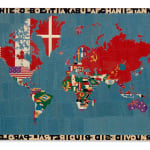


Alighiero Boetti Italian, 1940-1994
Mappa, 1983-84
Embroidery
114 x 168 cm. (44 7/8 x 66 1/8 in.)
Copyright The Artist
Further images
Alighiero Boetti was one of the most complex, innovative and influential artists of the late 20th century, producing a rich body of work that is at once conceptually rigorous and...
Alighiero Boetti was one of the most complex, innovative and influential artists of the late 20th century, producing a rich body of work that is at once conceptually rigorous and visually striking. The duality of his work is perhaps his trademark and what makes it so difficult for art historians to classify him within the art historical canon. While he was briefly associated with the Arte Povera movement in the late 1960s, he went on to work in a variety of media and methods in the 1970s until his premature death in 1994 that were truly distinctive and set him apart from the collective movements of those times.
Boetti traveled extensively in his lifetime, becoming increasingly fascinated by distant cultures antithetical to his own. Boetti traveled frequently to Afghanistan in the 1970s, where he began working with local artisans who executed his concepts through colourful embroidery, resulting in some of his most iconic works: Mappe, Arazzi and Tutto. Many of these craftswomen relocated to Peshawar, Pakistan, following the Soviet invasion of 1979, and continued collaborating with the artist until his untimely death in 1994.
The Mappe works were first conceived in 1969, inspired by Boetti filling in a blank map used in schools with the patterning of each country’s flag, as well as by his interest in various maps depicting war zones culled from media coverage of the Six-Day War in June 1967. In the 1970s, following specific directives from Boetti, the Afghan craftswomen laboriously hand-embroidered the Mappe, filling in the geopolitical borders with various national flags, though often elements, such as the colour of the sea and the surrounding borders of the maps were left to the interpretations, flourishes and available supplies of the weavers. These collaborations lasted over two decades, the maps serving as a record of shifting borders, the fall of the Berlin Wall, the collapse of the USSR and other major geopolitical changes. The Mappe not only reveal Boetti’s global consciousness but also his interest in the artificiality of borders, man’s desire for order within disorder, obsession with categorization and its undeniable ambiguity, authorship and collaboration.
Boetti traveled extensively in his lifetime, becoming increasingly fascinated by distant cultures antithetical to his own. Boetti traveled frequently to Afghanistan in the 1970s, where he began working with local artisans who executed his concepts through colourful embroidery, resulting in some of his most iconic works: Mappe, Arazzi and Tutto. Many of these craftswomen relocated to Peshawar, Pakistan, following the Soviet invasion of 1979, and continued collaborating with the artist until his untimely death in 1994.
The Mappe works were first conceived in 1969, inspired by Boetti filling in a blank map used in schools with the patterning of each country’s flag, as well as by his interest in various maps depicting war zones culled from media coverage of the Six-Day War in June 1967. In the 1970s, following specific directives from Boetti, the Afghan craftswomen laboriously hand-embroidered the Mappe, filling in the geopolitical borders with various national flags, though often elements, such as the colour of the sea and the surrounding borders of the maps were left to the interpretations, flourishes and available supplies of the weavers. These collaborations lasted over two decades, the maps serving as a record of shifting borders, the fall of the Berlin Wall, the collapse of the USSR and other major geopolitical changes. The Mappe not only reveal Boetti’s global consciousness but also his interest in the artificiality of borders, man’s desire for order within disorder, obsession with categorization and its undeniable ambiguity, authorship and collaboration.


